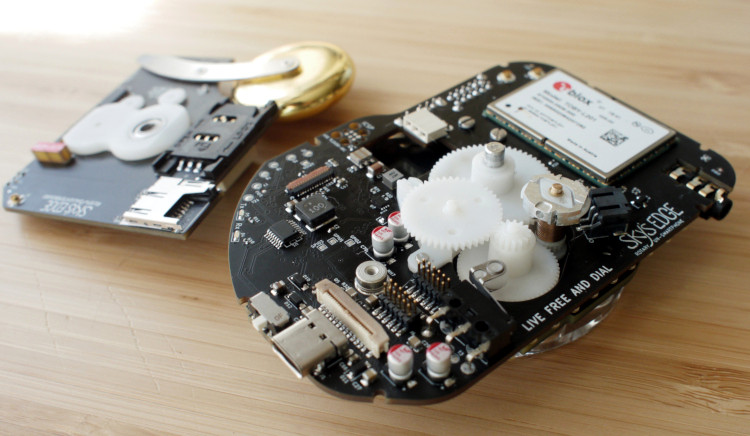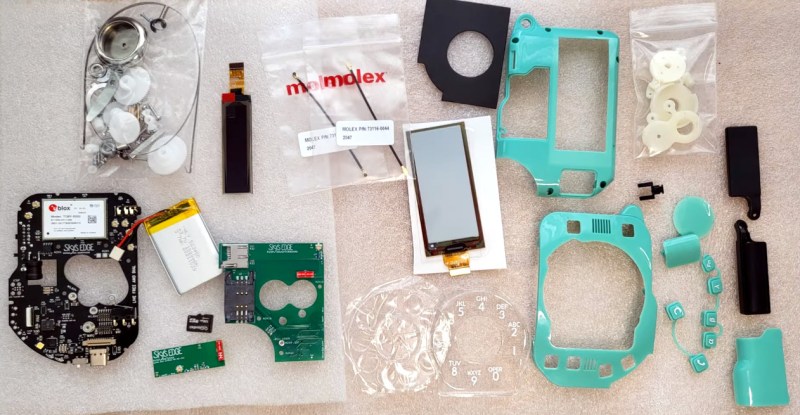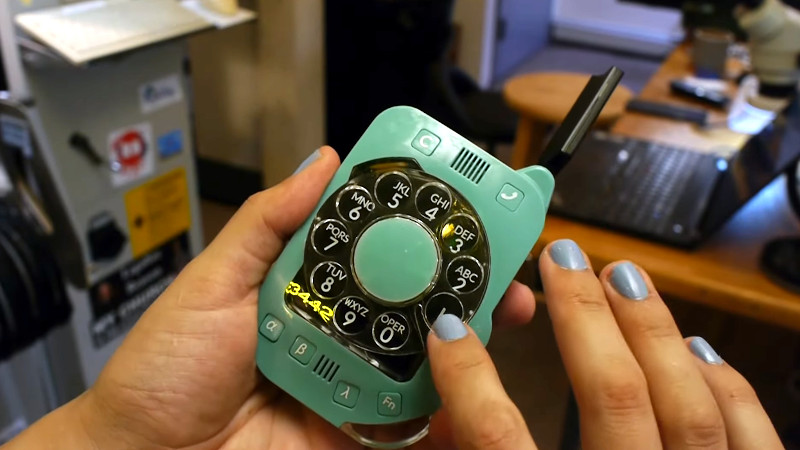We know the pandemic has screwed with a lot of people’s sense of time, but we doubled checked, and it has indeed been more than two years since the Internet first laid eyes upon the incredible rotary cell phone put together by [Justine Haupt]. We’re happy to report that not only has she continued to develop and improve the phone since the last time it made the rounds, but that the kits for this open source marvel are currently available for preorder.
A lot has happened since this phone last graced the pages of Hackaday. For one thing, it’s now officially known as the Rotary Un-Smartphone. [Justine] has also spun up a small company for the express purposes of putting these kits into production, which clearly speaks to just how much attention the project picked up in mainstream circles.

In terms of hardware, while the phone might look more or less the same externally, [Justine] says that there’s not a single unchanged component from the previous version. The 3D printed case has given way to a beautiful injection molded enclosure offered in several retro colors, and the rather incongruous rubber ducky antenna has been replaced with an articulated aerial that serves as a kickstand.
Speaking of reception, the original 3G cellular modem has been upgraded to a LTE-compatible model from uBlox, so it should still get a signal for a decade or so before your carrier kicks it off the network. When ordering the kit you can choose between a global version using the TOBY-R200 modem, or a North American variant with the TOBY-R202.
Even the user interface has been spruced up — while the previous model featured a simple LED indicator on the front to show when you were in a call, the new version features an OLED display that will show you the currently dialed number as well as status information such as battery life and signal strength. Some may be disappointed to hear that the authentic Western Electric model 10A rotary dial has been deleted in favor of a custom designed mechanism that uses all modern components, but we can certainly understand why the change had to be made from a production standpoint.

Perhaps the only thing that hasn’t changed is the commitment to making the device open source and hacker-friendly. The Rotary Un-Smartphone is still Arduino compatible, and as [Justine] demonstrates in the video below, you can even tap into the AT commands going between the microcontroller and cellular modem if you want to play around with some of the hardware’s more advanced capabilities. While the links to the source code admittedly point to a coming soon page at the time of this writing, we’re confident that [Justine] will deliver the goods. The kind of folks that take the time to write a rant about the benefits of open source can generally be trusted to do the right thing.
The original project was a masterclass in building hardware on your own terms, and we’re delighted to see that [Justine] has forged ahead with this new revision so that others might be able to realize the dream of owning a cell phone that doesn’t treat you like a product.
















That thing is gorgeous.
I really do want the smallest and simplest phone. I’d do this for the novelty! The one thing that I need to be included is mobile hotspot or some kind of tethering for when I want to mindlessly peruse websites just like this one on a cell connection. Am I the only one?
No you are not. That would make it a lot more useful.
No you are not. I was using my Wildfire S for a long time for communication only (phone, emails, whatsapp, sms etc) easily using one hand only with no fear of dropping it.
Today I would still like to have phone of this size for this purpose and when need to browse just give internet access to tablet or laptop.
Absolutely. I’m still using a Nokia 8110 4G because it’s small, light, has a good battery life and I can use it as a tether / hotspot, but KaiOS isn’t great and it’s no longer updated. If this phone had hotspot I’d buy one immediately.
I can imagine handing this to a kid, “How do you get Tik-Tok?”
I wonder if there will be an eventual software update for T-9 sms
She’s fake. This is actually Ernestine from the phone company. I recognise the voice. And the phone.
And just how many people here will be old enough to know who that is. Snort snort!
One Ringy Dingy.. Two Ringy Dingies…….. We know all about you… We are the phone company… We are omnipotent!
Tooo funny. We can do what we want. We’re the phone company.
I’m from Czech Republic, but I too know who the Ernestine is.
Does it handle calling international numbers? Everything seems to omit the country code, even the non-local.
As its open source (at least in theory – for now the it seems those parts are WIP and not on the web yet) it should be trivial to add that function if it needs any changes to the firmware. Which I don’t think it would – the carriers ‘switchboard’ should understand both and just work, where I’d guess the local number switch is the chosen method to make sending effectively incomplete phone numbers work.
But I really am not a mobile telecoms expert so I could be wrong – and the concept of ‘local’ mobile numbers new to me – I though it was national or international only having never come across ‘local’ area inside a nation mobile numbers – I thought that sort of local number was dying out with the landlines…
If I remember correctly: In Sweden a landline phone number looks like this today 0xxx-yyy yy(y) 0xxx is a area code and yyyyy(y) is the local number. For mobile phones it is 07a nnn nn nn, 07a tells the system it is mobile phone but a is not all numbers for legacy reasons. In practice the full 07a nnn nn nn or 0xxx-yyy yy(y) is necessary to dial a phone here these days.
It makes sense if you follow it from the beginning like how Tom Scott did for the British system here https://youtu.be/LsxRaFNropw
I didn’t not remember it all, there are exception for bigger cities for example (08-yy yyy yy(y) for the Stockholm area and 031-yy yy yy(y) for Göteborg is two i remember right now) and more stuff that I don’t remember.
Indeed its the fact there are so many subtle differences in this world that makes such things really complex rabbitholes, and suprising when for communication things globally tends to have fairly consistent standards now . Even if rather more than one of them…
Personally I’d never heard of ‘local’ calls on a mobile network at all as far as I can recall – just national and international.
obviously you were not born. The usual way was to “00” which accounts for + , then the international prefix, then the number itself. It´s still valid on most phones, try it.
In fact, the “+” is just an ITU notation for the local international prefix (00 of 09 in most countries). Everything that uses or is based on DTMF (every old fashioned landline) does not even know “+”
I think my biggest issue with it is that I’d have to start remembering phone numbers again.
Add a motor and controller. It uses the dial toenter numbers
Don’t worry, at the time, they used an adress book.
That’s what Maxwell Smart used with his shoephone. There was the episode with Don Rickles as an army body that makes use of that little black book.
It does have a contacts list. Seems like it could hold 100 or so contacts. After that do you really have 100 people you want to talk to? Texting, tragically (or mercifully), is likely gone (though you could do a Rotary T9 if you wanted to add that to the arduino) but if you loaded the right 100 they are all right on the back. Use it for weekends out to figure out where people are. If the bell vibrates enough it probably could work in a crowd for fun.
Goldfish brain means looking at the back several times while dialing XD
No no, just carry a Rolodex with you.
Just curious what the status/update is for the fully assembled (non kit) version? It looks awesome!
I think that’s kind of the point. To stop outsourcing one’s mind to the black scrying mirror in your pocket. Certainly comes as a trade-off. I used to have dozens of numbers memorized in the 90s, but now I think those pathways in my brain got re-routed to… who knows. Some new garbage that sucks, probably.
“the black scrying mirror” I bow to your brilliance. It made me shiver with newly revealed dread.
Surprised they didn’t mention the contacts list that you can keep on the micro SD card. There’s a mode on the phone that lets you quickly select from your saved contacts (using the backside-mounted eink display for reference) and call them that way.
It’s sensible, modern touches like this that’ll make the phone great to use when you aren’t feeling the novelty of dialing numbers manually.
Did you not watch the video? You add numbers to a micro SD, insert into phone, and now you have different pages of phone numbers to choose from to call. You wouldn’t have to remenber numbers, just type them onto your micro sd and they’re there. I don’t think you watched the video 🤦♂️
I really like the look and concept.
If it wasn’t so expensive (and likely to be even worse than it sounds once shipping and customs have mugged you for more money) I think I’d get two – my Dad loves his old rather worn out flip phone, largely because it doesn’t do any of this ‘smart bollocks’, so he’d probably love it, and I can imagine having lots of fun with it. Plus I really don’t use my phone for anything but phoning people on occasion, and perhaps once as a tethered hotspot (which I can’t see yet why this couldn’t do) so it meets my needs rather well too. Though I think it would also need a small firmware tweak so it can display text messages on the e-ink and type out a message by Morse (not that I’m good at it, but should be faster than rotary) if its worth responding.
What a fabulous creation :)
A long, coiled, heavy duty, color matched charging cable to complete the experience.
I need something to fiddle with during those long, awkward silences.
In two more years, will we see a Hackaday article about some nerd who’s built a robotic finger to dial this phone? I hope so…
Two or three articles about the same one, too. Same blog post and all. Calling it
Somewhere I have the program for my wallet sized phone book.
Not that I have the skills/time/cash to do it .
But couldn’t this be done as a case for a smartphone?
I’m thinking a Custom app for the numbers , the case could plug into the USB port for the buttons and the rotary encoder of the dial plate.
Have the USB a swap-able part for I-phone / Android and (pass-through ) ? , for charging while the case is on.
Kinda misses the point entirely, but it could be done
SHUT UP AND TAKE MY MONEY!!!
Is there an acoustic coupler available? I still have some AOL CDs I haven’t used up yet.
It has a headphone jack so that would be possible to add a handset for your coupler.
Indeed, I am sorely tempted. I would love a version with a transparent case.
I wish there were an even more basic version though; without the e-paper address book, or separate calling modes. I was thinking it’d make a great gift for a few people I know, but even that much would confuse and frustrate them. Having a speed-dial function is a good idea, but it needs to be as simple as possible; no more than one page. Maybe instead, the back could have a slot for an actual paper address book.
Like, I get that it’s not actually intended as a product for the tech-illiterate & the elderly, but it is just SO close to perfect for them.
Purchased it two days ago.
Has it arrived yet? Can I see?
That thing is a beauty… but I guess it’s too late, I’m fully addicted to my whatever not truly a phone now…
I’ll stay with my NoPhone Zero. Can do everything this beauty can, except make calls – at a fraction of the cost.
Bu-bu-but does it run Doom??
Not yet…
3… 2… 1…
If this had the option to use as an LTE hotspot, I’d buy in a heartbeat.
I hope it’s got the obligatory massive number 5 (most common number), like the Wasp T-12 – well futile. Believe.
No GPS, No social credit app or data, no adds, I’ll take it.
Who do you use as the carrier?
If there was a wifi/sip variant, I may get one for my parents.
IN MY HUMBLE 70 YR OLD OPINION, THAT PHONE IS PERFECT DON’T CHANGE A THING, MORE COLORS MAYBE👍👍👍😊
I ordered one of these, and am still yet to receive my order. That’s been over a year
Have you seen this forum, with this update?
https://forum.skysedge.com/viewtopic.php?t=138
Is this ever going to come out?
No, Justine lost her husband to cancer last year and despite a huge effort by her team, decided to pull the plug. Unfortunate for those wanting it, but fully understandable. See https://skysedge.com/2025/08/19/announcement.html
No, see https://skysedge.com/2025/08/19/announcement.html